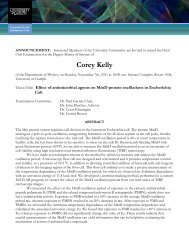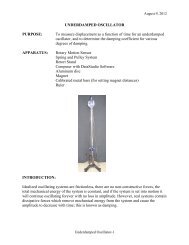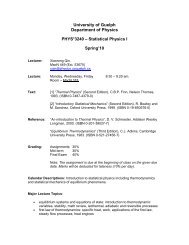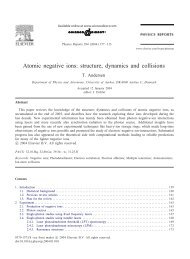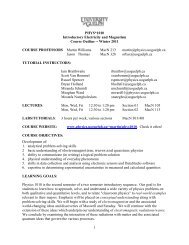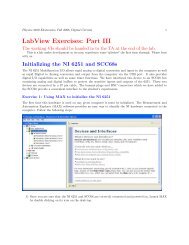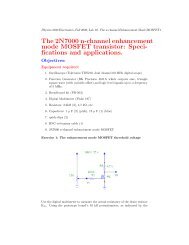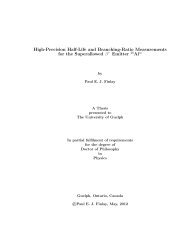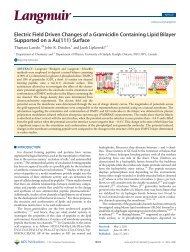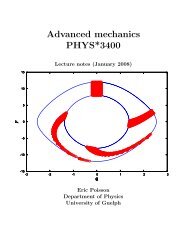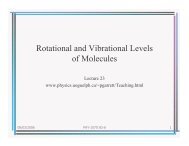Geant4 Simulations for the Radon Electric Dipole Moment Search at
Geant4 Simulations for the Radon Electric Dipole Moment Search at
Geant4 Simulations for the Radon Electric Dipole Moment Search at
Create successful ePaper yourself
Turn your PDF publications into a flip-book with our unique Google optimized e-Paper software.
(σ + ) along <strong>the</strong> axis of <strong>the</strong> B field, <strong>the</strong> transition must s<strong>at</strong>isfy <strong>the</strong> selection rule<br />
∆m F = +1. Because <strong>the</strong>re is no m F = +4 magnetic subst<strong>at</strong>e in <strong>the</strong> 2 P 1/2 excited<br />
st<strong>at</strong>e, see Figure 2.4, any electrons in <strong>the</strong> m F = +3 magnetic subst<strong>at</strong>e of <strong>the</strong> 2 S 1/2<br />
ground st<strong>at</strong>e will remain trapped <strong>the</strong>re. As <strong>the</strong> 2 P 1/2 excited st<strong>at</strong>es relax through<br />
photon emission <strong>the</strong> probability of popul<strong>at</strong>ing <strong>the</strong> m F = +3 magnetic subst<strong>at</strong>e of<br />
<strong>the</strong> 2 S 1/2 ground st<strong>at</strong>e is determined by <strong>the</strong> selection rule ∆m = ±1 or 0 <strong>for</strong> photon<br />
emission. After several S 1/2 - P 1/2 - S 1/2 pumping cycles almost all <strong>the</strong> <strong>at</strong>oms will<br />
end up trapped in <strong>the</strong> m F = +3 magnetic subst<strong>at</strong>e of <strong>the</strong> 2 S 1/2 level, and thus, <strong>the</strong><br />
m F = +3 ground st<strong>at</strong>e has been optically “pumped” into an ensemble of <strong>at</strong>oms with<br />
a very high degree of polariz<strong>at</strong>ion.<br />
2.3.2 Spin Exchange<br />
Opticallypumpedalkali-metal<strong>at</strong>omscanpolarizenoble-gas<strong>at</strong>omsviaspin-exchange<br />
interactions. TheHamiltonianth<strong>at</strong>describes <strong>the</strong>interactionbetween alkali-metaland<br />
noble-gas <strong>at</strong>oms is [29]<br />
H = AI·S+γN·S+αK·S+g s µ B B·S+g I µ B B·I+g K µ B B·K+··· , (2.15)<br />
where S is <strong>the</strong> spin of <strong>the</strong> alkai-metal valence electron, I is <strong>the</strong> alkai-metal nuclear<br />
spin, K is <strong>the</strong> noble-gas nuclear spin, N is <strong>the</strong> rot<strong>at</strong>ional angular momentum of <strong>the</strong><br />
<strong>for</strong>med alkai-metal noble-gas van der Waals molecule, and B is <strong>the</strong> external magnetic<br />
field.<br />
The transfer of angular momentum can occur while <strong>the</strong> <strong>at</strong>oms are bound in shortlived<br />
van der Waals molecules or by simple binary collisions between <strong>at</strong>oms, shown<br />
in Figure 2.5. For light noble gases, such as 3 He, binary collisions domin<strong>at</strong>e <strong>the</strong><br />
transfer of angular momentum and <strong>the</strong> contribution from van der Waals molecules is<br />
23



